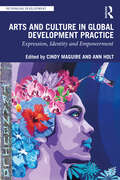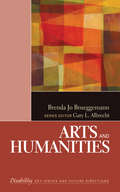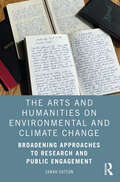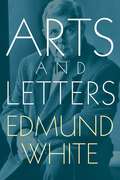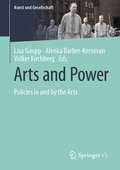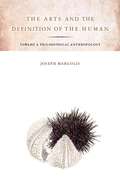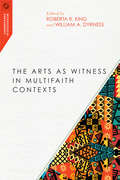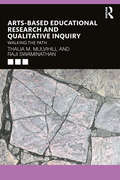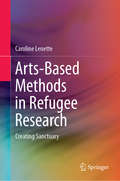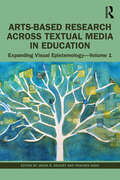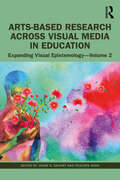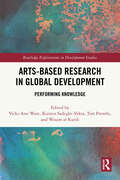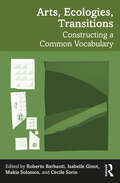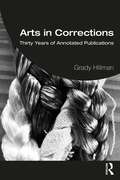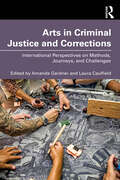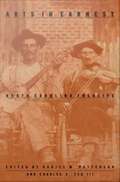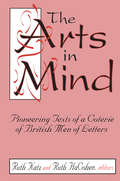- Table View
- List View
Arts and Culture in Global Development Practice: Expression, Identity and Empowerment (Rethinking Development)
by Cindy Maguire and Ann HoltThis book explores the role that arts and culture can play in supporting global international development. The book argues that arts and culture are fundamental to human development and can bring considerable positive results for helping to empower communities and provide new ways of looking at social transformation. Whilst most literature addresses culture in abstract terms, this book focuses on practice-based, collective, community-focused, sustainability-minded, and capacity-building examples of arts and development. The book draws on case studies from around the world, investigating the different ways practitioners are imagining or defining the role of arts and culture in Belize, Canada, China, Ethiopia, Guatemala, India, Kosovo, Malawi, Mexico, Peru, South Africa, Sri Lanka, Taiwan, Thailand, the USA, and Western Sahara refugee camps in Algeria. The book highlights the importance of situated practice, asking what questions or concerns practitioners have and inviting a dialogic sharing of resources and possibilities across different contexts. Seeking to highlight practices and conversations outside normative frameworks of understanding, this book will be a breath of fresh air to practitioners, policy makers, students, and researchers from across the fields of global development, social work, art therapy, and visual and performing arts education.
Arts and Humanities (The SAGE Reference Series on Disability: Key Issues and Future Directions)
by Brenda Jo BrueggemannThis volume in The SAGE Reference Series on Disability explores the arts and humanities within the lives of people with disabilities. It is one of eight volumes in the cross-disciplinary and issues-based series, which incorporates links from varied fields making up Disability Studies as volumes examine topics central to the lives of individuals with disabilities and their families. With a balance of history, theory, research, and application, specialists set out the findings and implications of research and practice for others whose current or future work involves the care and/or study of those with disabilities, as well as for the disabled themselves. The presentational style (concise and engaging) emphasizes accessibility. Taken individually, each volume sets out the fundamentals of the topic it addresses, accompanied by compiled data and statistics, recommended further readings, a guide to organizations and associations, and other annotated resources, thus providing the ideal introductory platform and gateway for further study. Taken together, the series represents both a survey of major disability issues and a guide to new directions and trends and contemporary resources in the field as a whole.
The Arts and Humanities on Environmental and Climate Change: Broadening Approaches to Research and Public Engagement
by Sarah SuttonThe Arts and Humanities on Environmental and Climate Change examines how cultural institutions and their collections can support a goal shared with the scientific community: creating a climate-literate public that engages with environmental issues and climate change in an informed way. When researchers, curators, and educators use the arts and humanities to frame discussions about environmental and climate change, they can engage a far wider public in learning, conversation, and action than science can alone. Demonstrating that archival and object-based resources can act as vital evidence for change, Sutton shows how the historical record, paired with contemporary reality, can create more personal connections to what many consider a remote experience: the changing climate. Providing valuable examples of museum collections used in discussions of environmental and climate change, the book shares how historic images and landscape paintings demonstrate change over time; and how documentary evidence in the form of archaeological reports, ships logs, Henry David Thoreau’s journals, and local reports of pond hockey conditions are being used to render climate data more accessible. Images, personal records, and professional documents have critical roles as boundary objects and proxy data. These climate resources, Sutton argues, are valuable because they make climate change personal and attract a public less interested in a scientific approach. This approach is underused by museums and their research allies for public engagement and for building institutional relevancy. The Arts and Humanities on Environmental and Climate Change will be most interesting to readers looking for ways to broaden engagement with environmental and climate issues. The ideas shared here should also act as inspiration for a broad spectrum of practitioners, particularly those writing, designing, and curating public engagement materials in museums, for wider research, and for the media.
Arts and Letters
by Edmund WhiteA dazzling collection of profiles and interviews by the preeminent American cultural essayist of our time. In these 39 lively essays and profiles, best-selling novelist and biographer Edmund White draws on his wide reading and his sly good humor to illuminate some of the most influential writers, artists, and cultural icons of the past century: among them, Marcel Proust, Catherine Deneuve, George Eliot, Andy Warhol, André Gide, David Geffen, and Robert Mapplethorpe. Whether he's praising Nabokov's sensuality, or critiquing Elton John's walk ("as though he's a wind-up doll that's been overwound and sent heading for the top of the stairs"), or describing serendipitous moments in his seven-year-long research into the life of Genet, White is unfailingly observant, erudite, and entertaining.
Arts and Minds: How the Royal Society of Arts Changed a Nation
by Anton HowesA major new history of the extraordinary society that has touched all aspects of British lifeFrom its beginnings in a coffee house in the mid-eighteenth century, the Royal Society for the Encouragement of Arts, Manufactures and Commerce has tried to improve British life in every way imaginable. It has sought to influence how Britons work, how they are educated, the music they listen to, the food they eat, the items in their homes, and even how they remember their own history. Arts and Minds is the remarkable story of an institution unlike any other—a society for the improvement of everything and anything.Drawing on exclusive access to a wealth of rare papers and artefacts from the Society's own archives, Anton Howes shows how this vibrant and singularly ambitious organisation has evolved and adapted, constantly having to reinvent itself to keep in step with changing times. The Society has served as a platform for Victorian utilitarian reformers, purchased and restored an entire village, encouraged the planting of more than sixty million trees, and sought technological alternatives to child labour. But this is more than just a story about unusual public initiatives. It is an engaging and authoritative history of almost three centuries of social reform and competing visions of a better world—the Society's members have been drawn from across the political spectrum, including Adam Smith, Edmund Burke, and Karl Marx.Informative and entertaining, Arts and Minds reveals how a society of public-spirited individuals tried to make their country a better place, and draws vital lessons from their triumphs and failures for all would-be reformers today.
Arts and Power: Policies in and by the Arts (Kunst und Gesellschaft)
by Lisa Gaupp Alenka Barber-Kersovan Volker KirchbergThe focus on concepts of power and domination in societal structures has characterized sociology since its beginnings. Max Weber’s definition of power as “imposing one’s will on others” is still relevant to explaining processes in the arts, whether their production, imagination, communication, distribution, critique or consumption. Domination in the arts is exercised by internal and external rulers through institutionalized social structures and through beliefs about their legitimacy, achieved by defining and shaping art tastes.The complexity of how the arts relate to power arises from the complexity of the policies of artistic production, distribution and consumption—policies which serve to facilitate or hinder an aesthetic object from reaching its intended public. Curators, critics and collectors employ a variety of forms of cultural and artistic communication to mirror and shape the dominant social, economic and political conditions.Arts and Power: Policies in and by the Arts brings together diverse voices who position the societal functions of art in fields of domination and power, of structure and agency—whether they are used to impose hegemonic, totalitarian or unjust goals or to pursue social purposes fostering equal rights and grassroots democracy. The contributions in this volume are exploratory steps towards what we believe can be a more systematic, empirically and theoretically founded sociological debate on the arts and power. And they are an invitation to take further steps.
The Arts and the Definition of the Human
by Joseph MargolisThe Arts and the Definition of the Humanintroduces a novel theory that our selves-our thoughts, perceptions, creativity, and other qualities that make us human-are determined by our place in history, and more particularly by our culture and language. Margolis rejects the idea that any concepts or truths remain fixed and objective through the flow of history and reveals that this theory of the human being (or "philosophical anthropology") as culturally determined and changing is necessary to make sense of art. He shows that a painting, sculpture, or poem cannot have a single correct interpretation because our creation and perception of art will always be mitigated by our historical and cultural contexts. Calling upon philosophers ranging from Parmenides and Plato to Kant, Hegel, and Wittgenstein, art historians from Damisch to Elkins, artists from Van Eyck to Michelangelo to Wordsworth to Duchamp, Margolis creates a philosophy of art interwoven with his philosophical anthropology which pointedly challenges prevailing views of the fine arts and the nature of personhood.
The Arts and the Teaching of History: Historical F(r)ictions
by Penney Clark Alan SearsThis book closely examines the pedagogical possibilities of integrating the arts into history curriculum at the secondary and post-secondary levels. Students encounter expressions of history every day in the form of fiction, paintings, and commemorative art, as well as other art forms. Research demonstrates it is often these more informal encounters with history that define students’ knowledge and understandings rather than the official accounts present in school curricula. This volume will provide educators with tools to bring together these parallel tracks of history education to help enrich students’ understandings and as a mechanism for students to present their own emerging historical perspectives.
The Arts as Witness in Multifaith Contexts (Missiological Engagements)
by William A. Dyrness Roberta R. KingIn search of holistic Christian witness, missionaries have increasingly sought to take into account all the dimensions of people's cultural and religious lives—including their songs, dances, dramatic performances, storytelling, and visual arts.
Arts-Based Educational Research and Qualitative Inquiry: Walking the Path
by Thalia M. Mulvihill Raji SwaminathanArts-Based Educational Research and Qualitative Inquiry introduces novice qualitative researchers, within education and related fields, to arts-based educational research (ABER). Abundant prompts and exercises are provided to help readers apply the concepts and experiment with various applications of the ideas presented. The authors walk the path with novice researchers offering a variety of approaches to the practice of arts-based methods, while providing a guided overview of ABER, and include pedagogical features in each chapter. Exercises are designed to assist educational researchers who wish to expand their repertoire of methodologies. The authors also weave into the discussion the possibilities and limitations of many types of arts-based methods while introducing readers to the growing methodological literature. By offering a tapestry of ways to engage the novice researcher, the book illustrates that it is not always possible to separate cognitive findings from aesthetic knowing. This book will help qualitative researchers to expand their methodologies to include arts-based approaches to their projects and by doing so reshape their identities as qualitative researchers. It also offers some evaluative criteria and tool kits for experimenting with various arts and educational research.
Arts-Based Methods in Refugee Research: Creating Sanctuary
by Caroline LenetteDrawn from a decade of refugee studies, this book offers a wealth of insights on arts-based methodologies. It explores exciting new prospects for participatory and culturally safe research, and will be a reference resource for researchers of all levels and community practitioners.The book tackles questions of meaningful research practice: How do people with lived experiences of forced migration—Knowledge Holders—lead the way? Can arts-based methods bring about policy and social change? And what of ethical issues?By reflecting on the strengths and limitations of four research methods (digital storytelling, photography, community music, and participatory video), readers are invited to craft their own approach to arts-based projects.
Arts-Based Research Across Textual Media in Education: Expanding Visual Epistemology - Volume 1
by Jason D. DeHart Peaches HashIn company with its sister volume, Arts-Based Research Across Textual Media in Education explores arts-based approaches to research across media, including film and comics-related material, from a variety of geographic locations and across a range of subdisciplines within the field of education. This first volume takes a textual focus, capturing process, poetic, and dramaturgical approaches. The authors aim to highlight some of the approaches that are not always centered in arts-based research. The contributors represent a variety of arts-based practices and methods, and they weave this marrying of artistic and scientific expertise and experience into the fabric of the chapters themselves. Authors from international contexts speak to the importance of utilizing artistic approaches for research processes. From multimodal field notes to poetic forms to the dramaturgical, chapters in this book represent steps forward in educational inquiry to bringing together both the creative and credible. The book includes multiple images and rich descriptions shared from the field. This first volume covers amongst other topics: co-created narratives, creative fiction in research, analytic portraits, dramatic representation, and critical poetic inquiry. It would be suitable for graduate students and scholars interested in qualitative inquiry and arts-based methods, in education and the social sciences.
Arts-Based Research Across Visual Media in Education: Expanding Visual Epistemology - Volume 2
by Jason DeHart Peaches HashIn company with its sister volume, this book explores arts-based approaches to research across media, including film and comics-related material, from a variety of geographic locations and across a range of subdisciplines within the field of education. This second volume has a focus exclusively on visual output and image-based research and methods. The book aims to highlight some of the approaches that are not always centered in arts-based research. The visual takes center stage as authors lead with comics-based representations, among other forms of arts-based inquiry. These chapters follow on from the first collection and serve to expand thinking about merging creative methods with analysis and exploration in the world of education. From mixtapes to the curatorial, these chapters showcase the ways in which scholars explore the multitude of human experiences. This second volume covers, among other topics: comics in qualitative research, visual journaling, multimodal fieldnotes and discourse, and creative visual outputs. It is suitable reading for graduate students and scholars interested in qualitative inquiry and arts-based methods, in education and the social sciences.
Arts-based Research in Global Development: Performing Knowledge (Routledge Explorations in Development Studies)
by Vicki-Ann Ware Kirsten Sadeghi-Yekta Tim Prentki Wasim Al KurdiThis book brings together a range of arts and development scholars and practitioners to explore the unique ways in which arts-based research methods can make a unique positive contribution to effective global development practice.Since the 1970s, global development has witnessed an increase in the use of participatory approaches to enable the world’s most excluded peoples to be actively involved in the planning and implementation of development projects that impact them. A range of participatory practices are now in common use, many of which use visual activities which enable fuller participation irrespective of literacy levels or social position. More recently, development practitioners with arts skills, along with a small number of professionally trained artists, have started engaging in a wider range of arts-based practices within this participatory development space, aimed at co-creating new knowledge with these communities. This book explores how the performing and visual arts provide spaces for the world’s most marginalised communities to articulate their development aspirations and co-create knowledge that contributes to development outcomes. It also highlights how arts-based research puts the power over development decisions back into the hands of ‘recipient’ communities.The book will be of interest to development practitioners and artists working with marginalised communities globally, policymakers in arts and global development, graduate students, and academics. The rich case studies provide many fresh ideas for arts and/or development practitioners wanting to utilise arts-based research, particularly with performing arts, in global development programming.
Arts-Based Research, Resilience and Well-being Across the Lifespan
by Susanne Garvis Georgina Barton Loraine McKay Viviana SappaThis book investigates how arts-based research methods can positively influence people’s resilience and well-being, particularly in constraining environments. Using examples from arts-based research methods in different contexts and from across the globe, the book brings together a diverse range of perspectives to understand how both resilience and well-being can be supported in a world that is rarely stress free. Collectively they demonstrate how arts-based research methods can: provide agency through the foregrounding of participants’ voices; afford transformational learning opportunities; create opportunities for relationship building; support creativity and new ways of thinking; generate aspirations and hope; encourage forms of communication that expose ideas, emotions and feelings that previously might not have been known or known how to be expressed; and enhance reflection and reflexivity. The authors explore how art-based practices, such as clowning, collage, dramatisation, drawing, painting, role-play and sculpting, can be used to support the resilience and well-being of individuals and groups across the lifespan, and theorize how arts-based research methods can positively contribute to participants’ positive self-esteem, self-image and ability to cope with challenges and new circumstances. Academics, professional learning facilitators, higher education students, and anyone interested in resilience and well-being in the health and education sectors will find this an interesting and engaging text.
Arts, Ecologies, Transitions: Constructing a Common Vocabulary
by Roberto Barbanti Isabelle Ginot Makis Solomos Cécile SorinArts, Ecologies, Transitions provides in-depth insights into how aesthetic relations and current artistic practices are fundamentally ecological and intrinsically connected to the world. As art is created in a given historic temporality, it presents specific modalities of productive and sensory relations to the world. With contributions from 49 researchers, this book tracks evolutions in the arts that demonstrate an awareness of the environmental, economic, social, and political crises. It proposes interdisciplinary approaches to art that clarify the multiple relationships between art and ecology through an exploration of key concepts such as collapsonauts, degrowth, place, recycling, and walking art. All the artistic fields are addressed from the visual arts, theatre, dance, music and sound art, cinema, and photography – including those that are rarely represented in research such as digital creation or graphic design – to showcase the diversity of artistic practices in transition.Through original research this book presents ideas in an accessible format and will be of interest to students and researchers in the fields of environmental studies, ecology, geography, cultural studies, architecture, performance studies, visual arts, cinema, music, and literature studies.
Arts in Corrections: Thirty Years of Annotated Publications
by Grady HillmanIn Arts in Corrections, the author—a poet, translator and teacher—takes readers on a chronological journey through an annotated selection of 24 of his own publications from 1981 to 2014 which recount his experiences teaching, consulting and documenting US arts programs in prisons, jails and juvenile facilities. Anyone interested in corrections and arts-in-corrections will be drawn in by the poetic sensibility Hillman brings to his writing. Readers will gain a historical and personal perspective not only into correctional arts programming in the US over the last 40 years, but also the institutional transformations in policy, culture, populations, economics, and the criminological mission expansion into other institutional settings like K-12 education. Original essays, articles, monographs and poems are interspersed with recent annotations to deliver not only a top-down view of the correctional system but also the author’s personal journey of "discouragement and hope" from work conducted in approximately 200 adult and juvenile facilities in 30 states and six countries. This comprehensive book is essential reading for a broad cross-section of international readers interested in and involved in the arts-in-corrections field. With two million individuals behind bars in the US at any given time, the profile of arts programs in prisons and jails is rising and interest in criminal-justice matters more generally is increasing. This includes not only arts-in-corrections professionals, policy makers, students, researchers, advocates and academics, but professionals in multiple other fields as well as the general public.
Arts in Criminal Justice and Corrections: International Perspectives on Methods, Journeys, and Challenges
by Amanda Gardner and Laura CaulfieldOffering a lively, international, and interdisciplinary introduction to research on arts programmes in prisons, Arts in Criminal Justice and Corrections is the first volume to bring together leading figures from the USA, the UK, Australia, New Zealand, and Belgium to explore key methodological approaches and issues through the lens of the researchers themselves.Beginning with the original pioneers of research into the arts in corrections in the USA in the 1980s, this book highlights the role of researchers in evidencing impact and influencing policy. Contributors include those who were themselves once incarcerated and those who have transitioned from practitioner to criminologist. Chapters lay the groundwork for discussion on how an important avenue for rehabilitation and re-entry can be developed, providing a call to action for more research into a field which holds promise for building a more just, equitable, and inclusive society.This book is essential reading for criminologists engaged in prisons, corrections, and desistance research, as well as researchers and practitioners in the arts and rehabilitation.
Arts in Earnest: North Carolina Folklife
by Daniel W. Patterson Charles G. Zug IIIArts in Earnest explores the unique folklife of North Carolina from ruddy ducks to pranks in the mill. Traversing from Murphy to Manteo, these fifteen essays demonstrate the importance of North Carolina's continually changing folklife. From decoy carving along the coast, to the music of tobacco chants and the blues of the Piedmont, to the Jack tales of the mountains, Arts in Earnest reflects the story of a people negotiating their rapidly changing social and economic environment. Personal interviews are an important element in the book. Laura Lee, an elderly black woman from Chatham County, describes the quilts she made from funeral flower ribbons; witnesses and friends each remember varying details of the Duke University football player who single-handedly vanquished a gang of would-be muggers; Clyde Jones leads a safari through his backyard, which is filled with animals made of wood and cement that represent nontraditional folk art; the songs and sermon of a Primitive Baptist service flow together as one--"it tills you up all over"; Durham bluesman Willie Trice, one of a handful of Durham musicians who recorded in the 1930s and early 1940s, remembers when the active tobacco warehouses offered ready audiences--"They'd tip us a heap of change to play some music"; and Goldsboro tobacco auctioneer H. L. "Speed" Riggs chants 460 words per minute, five to six times faster than a normal conversational rate.
The Arts in Mind: Pioneering Texts of a Coterie of British Men of Letters
by Ruth Katz Ruth HaCohen editorsAmajor shift in critical attitudes toward the arts took place in the eighteenth century. The fine arts were now looked upon as a group, divorced from the sciences and governed by their own rules. The century abounded with treatises that sought to establish the overriding principles that differentiate art from other walks of life as well as the principles that differentiate them from each other. This burst of scholarly activity resulted in the incorporation of aesthetics among the classic branches of philosophy, heralding the cognitive turn in epistemology. Among the writings that initiated this turn, none were more important than the British contribution. The Arts in Mind brings together an annotated selection of these key texts.A companion volume to the editors' Tuning the Mind, which analyzed this major shift in world view and its historical context, The Arts in Mind is the first representative sampling of what constitutes an important school of British thought. The texts are neither obscure nor forgotten, although most histories of eighteenth-century thought treat them in a partial or incomplete way. Here they are made available complete or through representative extracts together with an editor's introduction to each selection providing essential biographical and intellectual background. The treatises included are representative of the changed climate of opinion which entailed new issues such as those of perception, symbolic function, and the role of history and culture in shaping the world.>

